North American T-6 Texan
The North American Aviation T-6 Texan is an American single-engined advanced trainer aircraft used to train pilots of the United States Army Air Forces (USAAF), United States Navy, Royal Air Force, and other air forces of the British Commonwealth during World War II and into the 1970s. Designed by North American Aviation, the T-6 is known by a variety of designations depending on the model and operating air force. The United States Army Air Corps (USAAC) and USAAF designated it as the AT-6, the United States Navy the SNJ, and British Commonwealth air forces the Harvard, the name by which it is best known outside the US. Starting in 1948, the new United States Air Force (USAF) designated it the T-6, with the USN following in 1962. It remains a popular warbird aircraft used for airshow demonstrations and static displays. It has also been used many times to simulate various Japanese aircraft, including the Mitsubishi A6M Zero, in movies depicting World War II in the Pacific. A total of 15,495 T-6s of all variants were built.
| T-6 Texan/SNJ/Harvard | |
|---|---|
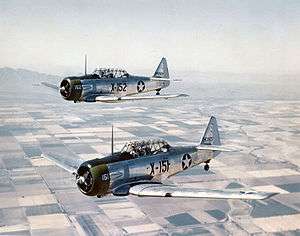 | |
| USAAF AT-6Cs near Luke Field, 1943 | |
| Role | Trainer aircraft |
| National origin | United States |
| Manufacturer | North American Aviation |
| First flight | 1 April 1935 |
| Retired | 1995 (South African Air Force) |
| Primary users | United States Army Air Forces United States Navy Royal Air Force Royal Canadian Air Force |
| Number built | 15,495 |
| Developed from | North American NA-16 |
| Variants | North American A-27 Bacon Super T-6 |
| Developed into | North American P-64 CAC Wirraway |
Development
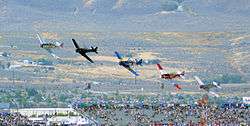
01.jpg)
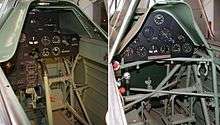
The Texan originated from the North American NA-16 prototype (first flown on April 1, 1935) which, modified as the NA-26, was submitted as an entry for a USAAC "Basic Combat" aircraft competition in March 1937. The first model went into production and 180 were supplied to the USAAC as the BC-1 and 400 to the RAF as the Harvard I. The US Navy received 16 modified aircraft, designated the SNJ-1, and a further 61 as the SNJ-2 with a different engine.
The BC-1 was the production version of the NA-26 prototype, with retractable tailwheel landing gear and the provision for armament, a two-way radio, and the 550-hp (410 kW) R-1340-47 engine as standard equipment. Production versions included the BC-1 (Model NA-36) with only minor modifications (177 built), of which 30 were modified as BC-1I instrument trainers; the BC-1A (NA-55) with airframe revisions (92 built); and a single BC-1B with a modified wing center-section.
Three BC-2 aircraft were built before the shift to the "advanced trainer" designation, AT-6, which was equivalent to the BC-1A. The differences between the AT-6 and the BC-1 were new outer wing panels with a swept-forward trailing edge, squared-off wingtips, and a triangular rudder, producing the canonical Texan silhouette. After a change to the rear of the canopy, the AT-6 was designated the Harvard II for RAF/RCAF orders and 1,173 were supplied by purchase or Lend Lease, mostly operating in Canada as part of the British Commonwealth Air Training Plan.
Next came the AT-6A which was based on the NA-77 design and was powered by the Pratt & Whitney R-1340-49 Wasp radial engine. The USAAF received 1,549 and the US Navy 270 (as the SNJ-3). The AT-6B was built for gunnery training and could mount a .30 caliber machine gun on the forward fuselage. It used the R-1340-AN-1 engine, which was to become the standard for the remaining T-6 production. Canada's Noorduyn Aviation built an R-1340-AN-1-powered version of the AT-6A, which was supplied to the USAAF as the AT-16 (1,500 aircraft) and the RAF/RCAF as the Harvard IIB (2,485 aircraft), some of which also served with the Fleet Air Arm and Royal Canadian Navy.
In late 1937, Mitsubishi purchased two NA-16s as technology demonstrators and possibly a licence. However, the aircraft developed by Watanabe/Kyushu as the K10W1 (Allied code name Oak) bore no more than a superficial resemblance to the North American design. It featured a full monocoque fuselage as opposed to the steel tube fuselage of the T-6 and NA-16 family of aircraft, as well as being of smaller dimensions overall and had no design details in common with the T-6. It was used in very small numbers by the Imperial Japanese Navy from 1942 onwards. None survived the end of the war, and after the war, the Japanese Air Self Defense Force operated Texans.
The NA-88 design resulted in 2,970 AT-6C Texans and 2,400 as the SNJ-4. The RAF received 726 of the AT-6C as the Harvard IIA. Modifications to the electrical system produced the AT-6D (3,713 produced) and SNJ-5 (1,357 produced). The AT-6D, redesignated the Harvard III, was supplied to the RAF (351 aircraft) and Fleet Air Arm (564 aircraft). When the USAF was created in 1948, its final production variant was nominated T-6G (SNJ-7) and involved major advancements including a full-time hydraulic system and a steerable tailwheel and persisted into the 1950s as the USAF advanced trainer.
Subsequently, the NA-121 design with a completely clear rearmost section on the canopy, gave rise to 25 AT-6F Texans for the USAAF and 931, as the SNJ-6 for the US Navy. The ultimate version, the Harvard 4, was produced by Canada Car and Foundry during the 1950s, and supplied to the RCAF, USAF and Bundeswehr.
A total of 15,495 T-6s of all variants were built.
Operational history
Combat use
Twenty AT-6 Texans were employed by the 1st and 2nd fighter squadrons of the Syrian Air Force in the 1948 Arab-Israeli War, providing ground support for Syrian troops, and launching air strikes against Israeli airfields, ships, and columns, losing one aircraft to antiaircraft fire. They also engaged in air-to-air combat on a number of occasions, with a rear gunner shooting down an Israeli Avia S-199 fighter.[1]
The Israeli Air Force (IAF) bought 17 Harvards, and operated nine of them in the final stages of the 1948 Arab-Israeli War, against the Egyptian ground forces, with no losses. In the Sinai Campaign, IAF Harvards attacked Egyptian ground forces in Sinai Peninsula with two losses.

The Royal Hellenic Air Force employed three squadrons of British- and American-supplied T-6D and G Texans for close air support, observation, and artillery spotting duties during the Greek Civil War, providing extensive support to the Greek army during the Battle of Gramos. Communist guerillas called these aircraft "O Galatas" ("The Milkman"), because they saw them flying very early in the morning. After the "Milkmen", the guerillas waited for the armed Spitfires and Helldivers.
During the Korean War and, to a lesser extent, the Vietnam War, T-6s were pressed into service as forward air control aircraft. These aircraft were designated T-6 "Mosquitos".[2][3]
No. 1340 Flight RAF used the Harvard in Kenya against the Mau Mau in the 1950s, where they operated with 20-lb bombs and machine guns against the rebels. Some operations took place at altitudes around 20,000 ft above mean sea level. A Harvard was the longest-serving RAF aeroplane, with an example, taken on strength in 1945, still serving in the 1990s (as a chase plane for helicopter test flights—a role for which the Shorts Tucano's high stall speed was ill-suited).
The T-6G was also used in a light attack or counter insurgency role by France during the Algerian War in special Escadrilles d'Aviation Légère d'Appui (EALA), armed with machine guns, bombs and rockets. At its peak, 38 EALAs were active. The largest unit was the Groupe d'Aviation Légère d'Appui 72, which consisted of up to 21 EALAs.
From 1961 to 1975, Portugal used more than a hundred T-6Gs, also in the counterinsurgency role, during the Portuguese Colonial War. During this war, almost all the Portuguese Air Force bases and air fields in Angola, Mozambique, and Portuguese Guinea had a detachment of T-6Gs.
On 16 June 1955, rebel Argentine Navy SNJ-4s bombed Plaza de Mayo in Buenos Aires, Argentina; one was shot down by a loyalist Gloster Meteor. Navy SNJ-4s were later used by the colorado rebels in the 1963 Argentine Navy Revolt, launching attacks on the 8th Tank Regiment columns on 2 and 3 April, knocking out several M4 Sherman tanks, and losing one SNJ to anti-aircraft fire.[4]
In 1957–58, the Spanish Air Force used T-6s as counterinsurgency aircraft in the Ifni War, armed with machine guns, iron bombs, and rockets, achieving an excellent reputation due to its reliability, safety record, and resistance to damage.
The Pakistan Air Force used T-6Gs in the Indo-Pakistani War of 1971 as a night ground-support aircraft, hitting soft transport vehicles of the Indian army. In the early hours of 5 December, during a convoy interdiction mission in the same area, Squadron Leader Israr Quresh's T-6G Harvard was hit by Indian antiaircraft ground fire and a shell fractured the pilot's right arm. Profusely bleeding, the pilot flew the aircraft back with his left hand and landed safely. The World War II-vintage propellered trainers were pressed into service and performed satisfactorily in the assigned role of convoy escorters at night.
The South African Air Force received their first T-6's in October 1942 to be used by the Joint Air Training Scheme. By July 1944, 633 Harvard Mk IIA T-6s and IIIs had been shipped to South Africa with another 555 (379 MkIIAs and 176 Mk IIIs) to arrive by October 1945. Another 65 (AT-6Ds and 30 T-6Gs) were ordered between 1952-1956.[5] The T-6 remained in service until 1995 as a basic trainer, mainly as a result of the United Nations arms embargo against South Africa's apartheid policies. They were replaced by Pilatus PC-7 MkII turboprop trainers.[6]
Research testbed
The Harvard 4 has been used in Canada as a testbed aircraft for evaluating cockpit attitude displays. Its aerobatic capability permits the instructor pilot to maneuver the aircraft into unusual attitudes, then turn the craft over to an evaluator pilot in the "blind" rear cockpit to recover, based on one of several digitally generated attitude displays.[7]
Variants
Operators
.jpg)
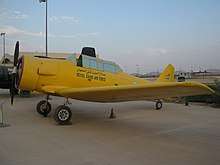
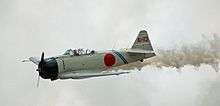
- Argentine Army Aviation (SNJ-4)
- Argentine Naval Aviation (SNJ-4 and 30 SNJ-5Cs for carrier operations)
- Biafran Air Force[8]
- Bolivian Air Force
- Naval Aviation
- Royal Khmer Aviation (AVRK)
- Royal Canadian Air Force
- Royal Canadian Navy
- National Research Council (still in use)
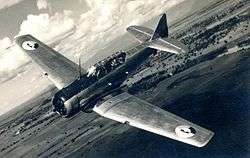
- Congolese Air Force
- Cuban Air and Air Defense Force
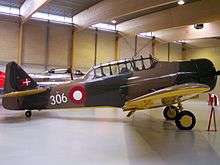
- Dominican Air Force
- Air Force of El Salvador
- Gabon Air Force
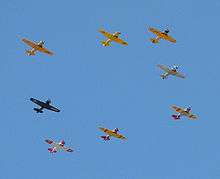
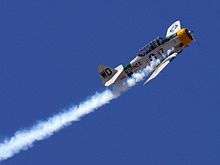
- German Air Force (Bundeswehr Luftwaffe)
- Haiti Air Corps
- Honduran Air Force
- Royal Indian Air Force
- Indian Air Force
- Indonesian Air Force – buying 25 from US.
- Iranian Air Force
- Italian Air Force operated 238 aircraft from 1949 until 1979[9]
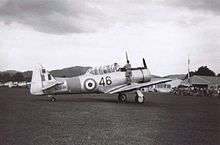
- Force Aérienne Katangaise[10]
- Mexican Air Force Total of 120 delivered, 47 AT-6 and 73 T-6C
- Royal Netherlands Air Force
- Dutch Naval Aviation Service
- Royal Netherlands East Indies Army Air Force – Post war
- Mozambique Air and Air Defense Forces
- Royal New Zealand Air Force (1 maintained for historic flight)
- Royal Norwegian Air Force (1 maintained for historic flight)
- Fuerza Aérea de Nicaragua (G.N) Escuela Militar de Aviación 1948-1979
- Paraguayan Air Force
- Paraguayan Naval Aviation
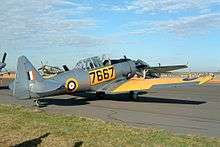

- Southern Rhodesian Air Force
- Republic of Vietnam Air Force
- Swedish Air Force 145 Harvard IIb as Sk 16A, 106 T-6A, T-6B, SNJ-3, SNJ-4 as Sk 16B and 6 SNJ-2 as Sk 16C.
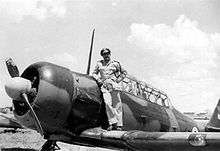 Syrian Harvard
Syrian Harvard
- Turkish Air Force: 196 planes of various types
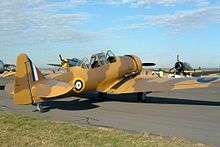
- Royal Air Force
- Royal Navy
- Qinetiq (retired in 2016)[11][12]
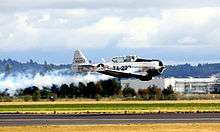
- United States Army Air Corps/Army Air Forces
- United States Air Force
- United States Navy
- United States Marine Corps
- United States Coast Guard
- Uruguayan Air Force
- Aviacion Naval Uruguaya

- SFR Yugoslav Air Force
Specifications (T-6G)
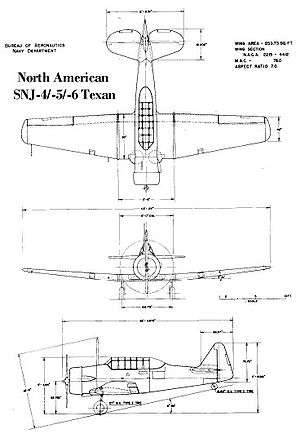
Data from Jane's Fighting Aircraft of World War II[13]
General characteristics
- Crew: two (student and instructor)
- Length: 29 ft 0 in (8.84 m)
- Wingspan: 42 ft 0 in (12.81 m)
- Height: 11 ft 8 in (3.57 m)
- Wing area: 253.7 sq ft (23.6 m2)
- Empty weight: 4,158 lb (1,886 kg)
- Gross weight: 5,617 lb (2,548 kg)
- Powerplant: 1 × Pratt & Whitney R-1340-AN-1 Wasp radial engine, 600 hp (450 kW)
Performance
- Maximum speed: 208 mph (335 km/h, 181 kn) at 5,000 ft (1,500 m)
- Cruise speed: 145 mph (233 km/h, 126 kn)
- Range: 730 mi (1,175 km, 630 nmi)
- Service ceiling: 24,200 ft (7,400 m)
- Rate of climb: 1,200 ft/min (6.1 m/s)
- Wing loading: 22.2 lb/sq ft (108 kg/m2)
- Power/mass: 0.11 hp/lb (kW/kg)
Armament
- Provision for up to 3× 0.30 in (7.62 mm) machine gun
In popular culture
After World War II, the National Air Races established a unique racing class for the AT-6/Texan/Harvard aircraft; this class continues today at the Reno National Air Races each year.
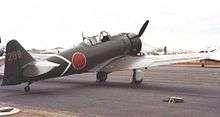
.jpg)
Since the Second World War, the T-6 has been a regular participant at air shows, and was used in many movies and television programs. For example, converted single-seat T-6s painted in Japanese markings to represent Mitsubishi Zeros made appearances in A Yank in the R.A.F. (1941), Tora! Tora! Tora! (1970), Baa Baa Black Sheep (1976-1978), and The Final Countdown (1980). In A Bridge too Far (1977) it represented the razorback Republic P-47 Thunderbolt. Some were modified for the Dutch film Soldaat van Oranje (1977) to represent the Dutch pre-World War II fighter Fokker D.XXI. The T-6 also appeared in the Pat Benatar video for Shadows of the Night. The New Zealand Warbirds "Roaring 40s" aerobatic team use ex-Royal New Zealand Air Force Harvards. The Flying Lions Aerobatic Team uses Harvards acquired from the South African Air Force.[14]
See also
- T-6 Texan variants
- T-6 Texan II
Related development
Aircraft of comparable role, configuration and era
- Arado Ar 96
- Fiat G.49
- Kyushu K10W
- FMA I.Ae. 22 DL
- Macchi MB.323
- Miles Master
- Percival Provost
- Piaggio P.150
- Soko 522
- Valmet Vihuri
- VL Pyry
- Yakovlev Yak-11
- PZL TS-8 Bies
Related lists
- List of aircraft of World War II
- List of military aircraft of the United States
- List of aircraft of the RAF
- List of aircraft of the RNZAF
References
Notes
- Nicolle, David. "Syria's Fighting Texans". ACIG.org. Retrieved 30 January 2013.
- "AF Museum – North American T-6D "Mosquito"". National Museum of the US Air Force. Retrieved 4 October 2015.
- "North American AT-6/SNJ-6". Lyon Air Museum.
- Cooper, Tom. "Argentina, 1955–1965". ACIG.org. Retrieved 23 January 2013.
- "The South African Air Force". www.saairforce.co.za. Retrieved 2020-06-25.
- "The History of the SAAF". www.af.mil.za. Archived from the original on 2012-05-05. Retrieved 2009-11-12.
- http://archive.nrc-cnrc.gc.ca/obj/iar-ira/doc/harvard_eng.pdf%5B%5D
- Jowett, Philip (2016). Modern African Wars (5): The Nigerian-Biafran War 1967-70. Oxford: Osprey Publishing Press. p. 19. ISBN 978-1472816092.
- "Italian Air Force Aircraft Types". www.aeroflight.co.uk.
- "Congo, Part 1; 1960–1963". ACIG. 2003. Retrieved 2013-08-09.
- KF183 Retrieved March 8, 2017
- Qinetiq's Last Harvard Departs Air Forces Monthly p8 January 2017
- Bridgeman, Leonard. "The North American Texan." Jane's Fighting Aircraft of World War II. London: Studio, 1946. p. 251. ISBN 1 85170 493 0.
- "Team fact sheet" (PDF). Eqstra.co.za. Archived from the original (PDF) on 24 March 2014. Retrieved 23 March 2014.
Bibliography
- Becker, Dave and Brent, Winston. AT-6 Harvard in South African Service (African Aviation Series No.1). Nelspruit, South Africa:, Freeworld Publications CC, 2000. ISBN 0-9583880-2-4.
- Bergése, Francis. North American T-6 (in French). Rennes, France: Ouest France, 1979. ISBN 2-85882-183-6.
- Davis, Larry. T-6 Texan in Action (Aircraft Number 94). Carrollton, TX: Squadron/Signal Publications, Inc., 1989. ISBN 0-89747-224-1.
- Donald, David. American Warplanes of World War II. London:Aerospace Publishing, 1995. ISBN 1-874023-72-7.
- Fletcher, David C. and MacPhail, Doug. Harvard! the North American Trainers in Canada. San Josef, BC/Dundee, Ont: DCF Flying Books, 1990. ISBN 0-9693825-0-2.
- Hagedorn, Dan. North American NA-16/AT-6/SNJ (WarbirdTech Volume 11). North Branch, MN: Speciality Press, 1997. ISBN 0-933424-76-0.
- Hamlin, John F. The Harvard File. Tonbridge, Kent, UK: Air-Britain (Historians) Ltd., 1988. ISBN 0-85130-160-6.
- Jesse. William. T-6 Texan, the Immortal Pilot Trainer. London: Osprey Publishing Ltd., 1991. ISBN 1-85532-154-8.
- Kohn, Leo J. The Story of the Texan (American Flight Manuals). Aviation Publications Co., 1975. ISBN 0-87994-034-4.
- MacPhail, Doug and Östberg, Mikael. Triple Crown BT-9: The ASJA/Saab Sk 14, A Pictorial Essay (in English/Swedish). San Josef, BC/Dundee, Ont: DCF Flying Books, 2003.
- Marchand, Patrick and Takamori, Junko. North American T-6 et derives (in French). Le Muy, France: Editions d'Along, 2004. ISBN 2-914403-21-6.
- Morgan, Len. Famous Aircraft Series: The AT-6 Harvard. New York: Arco Publishing Co., Inc., 1965.
- Olrich, Walter and Ethell, Jeffrey L. Pilot maker; the Incredible T-6. North Branch, MN: Specialty Press, 1982. ISBN 0-933424-34-5.
- Smith, Peter Charles. North American T-6: SNJ, Harvard and Wirraway. Ramsbury, Marlborough, Wiltshire, UK: The Crowood Press Ltd., 2000. ISBN 1-86126-382-1.
- Smith, Peter Charles. T-6: The Harvard, Texan & Wirraway – A Pictorial Record. North Branch, MN: Speciality Press, 1995. ISBN 0-7603-0191-3.
- Spring, Ivan and Rivers, Reg. Colour schemes and special markings of the North American "Harvard" in service with the SAAF 1940 to 1995. Pretoria, SOuth Africa: Spring Air Publishers, 1996. ISBN 0-9583977-3-2.
- Starkings, Peter. From American Acorn to Japanese Oak – The tale of an unsung Japanese training aircraft with roots extending across the Pacific Ocean. Arawasi International, Asahi Process, September–December 2007, Issue 7.
- Swanborough, Gordon and Bowers, Peter M. United States Military Aircraft since 1909. London:Putnam, 1963.
- Wache, Siegfried. CCF Harvard Mk. IV (T-6) (series F-40 – Die Flugzeuge der Bundeswehr Nr.09) (in German). Buchholz, Germany: Buchholz Medien Verlag, 1989. ISBN 3-935761-09-0.
External links
| Wikimedia Commons has media related to T-6 Texan. |
- Warbird Alley: T-6/SNJ/Harvard page – History, photos, specs, and links
- Texan, Harvard & SNJ Registry – Lists approximately 1,200 extant T-6's by serial number
- The Canadian Harvard Aircraft Association
- Backgrounder on the Harvard 4 (includes photographs)
- AT-6: School Marm With an Attitude (pilot report)
- "A Yank at Grantham: First North American "Basic" Trainer Delivered to the R.A.F. : The Harvard Described Flight 1939
- T.O. TT-6C-2 Handbook Erection and Maintenance Instructions T-6, -6A, 6B USAF Model T-6C, T-6D Navy Models SNJ-3, SNJ-4, SNJ-5, SNJ-6 (1956)
- Pacific Warbirds: North American SNJ – History, restoration, service & more